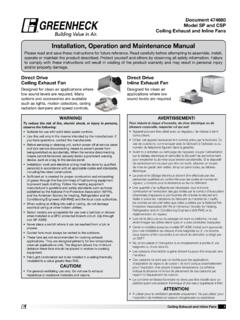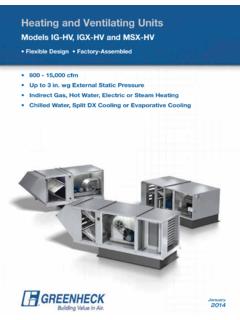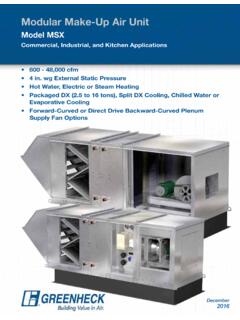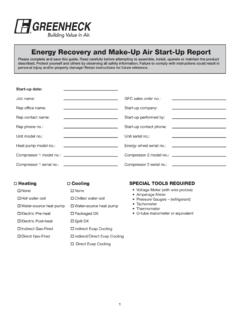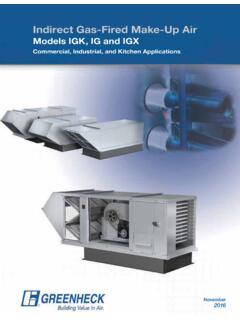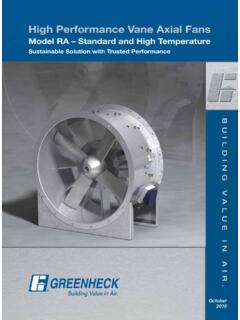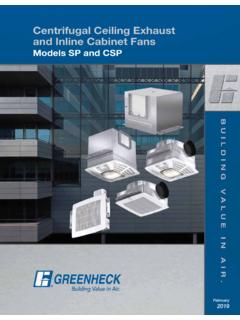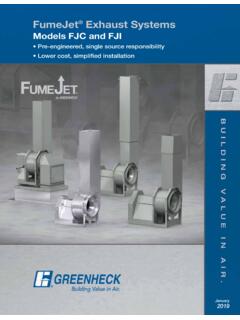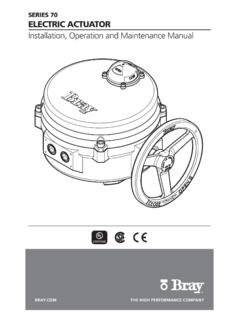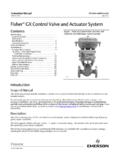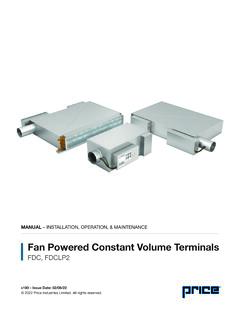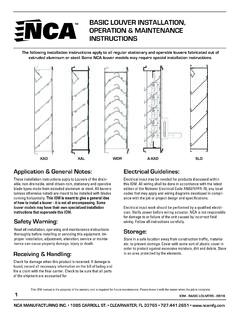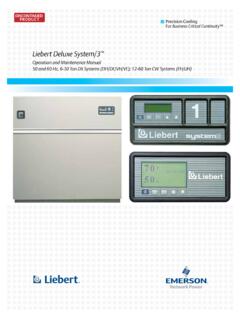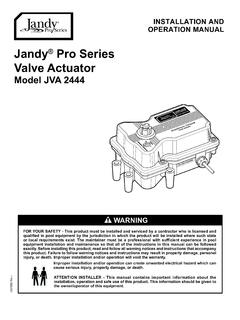Transcription of Installation Operation and Maintenance Manual
1 Table of ContentsGeneral Information ..2 Pre- Installation Guidelines ..2 Electrical Guidelines ..2 Installation ..3-11 Preparation of Openings ..3 Clearances Required Between Damper Sleeves & Wall/Floor Openings ..4 Installing Multiple Damper Section Assemblies ..4-5 Multiple Section Damper Wiring ..5 Maximum Assembly Tables ..5 Inserting Damper into Wall/Floor Openings ..6 Securing the Damper/Sleeve Assembly to Wall/Floor Openings ..7-8 Duct to Sleeve Connection ..9-10 actuator & Temperature Response Device Connections ..11 Commissioning and Periodic Testing ..12 Maintenance ..12 Troubleshooting ..12 These instructions apply to 11 2 and 3 hour rated fire and combination fire smoke dampers mounted in: 1) masonry, block, or stud walls and 2) concrete floors. Specific requirements in these instructions are mandatory. Dampers must be installed in accordance with these instructions to meet the requirements of UL 555 and/or UL : Combination fire smoke and fire dampers are manufactured and labeled for either vertical or horizontal Installation .
2 The dampers must be installed in accordance with and HandlingUpon receiving dampers, check for both obvious and hidden damage. If damage is found, record all necessary information on the bill of lading and file a claim with the final carrier. Check to be sure that all parts of the shipment, including accessories, are accounted must be kept dry and clean. Indoor storage and protection from dirt, dust and the weather is highly recommended. Do not store at temperatures in excess of 100 F (38 C).This Manual is the property of the owner and is required for future Maintenance . Please leave it with the owner when the job is WarningImproper Installation , adjustment, alteration, service or Maintenance can cause property damage, injury or death. Read the Installation , operating, and Maintenance instructions thoroughly before installing or servicing this equipment. Multi-Blade Fire and Combination Fire Smoke Dampers1 Document 481318 Multi-Blade Fire and Combination Fire Smoke DamperDFD-xxx, DFDAF-xxx, FSD-xxx, FSD-xxxV, IMO-xxx, SEDFD-xxx, SEFSD-xxx, and SSFSD-xxx11 2 and 3 Hour Fire and Combination Fire Smoke Dampers (with factory installed sleeve and actuator ) Installation , Operation and Maintenance ManualPlease read and save these instructions for future reference.
3 Read carefully before attempting to assemble, install, operate or maintain the product described. Protect yourself and others by observing all safety information. Failure to comply with these instructions will result in voiding of the product warranty and may result in personal injury and/or property InformationInstallation SupplementsRefer to the appropriate Greenheck Installation supplements for special requirements: Concrete Floor with Steel Deck Drive Slip Breakaway Connection Field Installed Sleeve Fire Resistant Ventilated Duct Assembly Firestop Material Fusible Link Replacement Greenheck Test Switch Grille Installation Metal Stud in Shaftwall Partition Non-Concrete Horizontal Mount Open or Close Indicator (OCI) Quick Connect Breakaway Connection Resettable Link (RRL) Resettable Link with Blade Indicator (RRL/OCI) Sealant Supplement Single 3-Sided Retaining Angle Supplement Sleeve Extension Smoke Detector - Various Types Temperature Limited Override (TOR) Tunnel CorridorInstallation supplements available at following items will aid in completing the damper Installation in a timely and effective ) Check the drawings for proper damper locations within the building.
4 Visually inspect the damper for damage and verify that the Reusable Resettable Link (RRL) is in place and has not activated if provided. These electric links have a button for resetting. Visually inspect the fusible link (if provided) to verify its not missing or broken. Replace link as ) Lift or handle damper using sleeve or frame. Do not lift damper using blades or ) Damper has label on outside of sleeve indicating a No Screw area. Do not install screws into this area as screws may interfere with unexposed blade linkage and prevent damper blades from opening and/or ) Damper has label indicating position of damper and sleeve assembly in the wall. Install accordingly to comply with manufacturer s appropriate UL Classification file ) Damper must be installed into duct or opening square and free of twist or other misalignment. Out of square, racked, twisted or misaligned installations can cause excessive leakage and/or torque requirements to exceed damper/ actuator ) Damper and actuator must be kept clean and protected from dirt, dust and other foreign materials prior to and after Installation .
5 Examples of such foreign materials include but are not limited to: a) Mortar dust b) Drywall dust c) Firesafing materials d) Wall texture e) Paint overspray7) Damper should be sufficiently covered as to prevent overspray if wall texturing or spray painting will be performed within 5 feet of the damper. Excessive dirt or foreign material deposits on the damper can cause excessive leakage and/or torque requirements to exceed damper/ actuator ) Caulking is not necessary, nor is it allowed, between the damper sleeve and the wall or floor opening (annular space). However, caulking may be applied to the retaining ) ACCESS: Suitable access (such that RRL s and actuators can be maintained, etc.) must be provided for damper inspection and servicing. Where it is not possible to achieve sufficient size access, it will be necessary to install a removable section of duct. (Refer to NFPA 90A).10) The Code Authority Having Jurisdiction (AHJ) must evaluate and provide approval of final Installation where variations to these instructions are GuidelinesAll wiring shall be done in accordance with the National Electrical Code ANSI/NFPA-70 latest edition, any local codes that may apply, and wiring diagrams developed in compliance with the job or project design and specifications.
6 Important!Electrical input may be needed for this equipment. This work should be performed by a qualified electrician. Verify power before wiring actuator . Greenheck is not responsible for any damage to, or failure of the unit caused by incorrect field wiring. To avoid causing death or serious bodily harm to building occupants, follow all instructions carefully. Dampers must close completely to preserve the integrity of the fire smoke GuidelinesPre- Installation Guidelines UL CLASSIFIED (see complete marking on product) UL CLASSIFIED to Canadian safety standards (see complete marking on product) Standard 555 & 555S (Listing #R13317)Multi-Blade Fire and Combination Fire Smoke Dampers2 Preparation of Openings Frame wall openings as shown below (see Figure 1, 2, and 2A). Gypsum wall board must be fastened 12 in. (305mm) on center ( ) to all stud and runner flanges surrounding opening. Prepare opening between studs and sleeve assembly as shown below (see Figure 3 & 4).
7 All construction and fasteners must meet the requirements of the appropriate wall design (See UL Fire Resistance Directory) and/or local 112 in. RunnerCeiling Runner24 in. (metal studs)24 in. (metal studs)16 in. (wood studs)16 in. (wood studs)2 in. (51mm)2 in. (51mm)2 Panhead ScrewsSecond set of studs are not required on openings 36 in. x 36 in. (914mm x 914mm) or 2 Second set of studs are not required on openings36 in. x 36 in. (914mm x 914mm) or stud onlySecond set of studs are not required on openings36 in. x 36 in. (914mm x 914mm) or stud onlyMetal Stud ConstructionWooden Stud ConstructionIn wood stud construction,gypsum wallboard must coverall wood stud WallboardStud or RunnerRetainingAngle1 in. metal stud construction,exposed steel surfaces neednot be covered with WallboardStud or RunnerRetainingAngle1 in. 3 (2 sided angle Installation shown)Metal Stud ConstructionWooden Stud ConstructionIn wood stud construction,gypsum wallboard must coverall wood stud WallboardStud or RunnerRetainingAngle1 in.
8 Metal stud construction,exposed steel surfaces neednot be covered with WallboardStud or RunnerRetainingAngle1 in. 4 (2 sided angle Installation shown)Figure 2 AMulti-Blade Fire and Combination Fire Smoke Dampers3 Clearances Required Between Damper Sleeves & Wall/Floor OpeningsTwo-Sided Angle InstallationTwo-sided angle installations require clearances for thermal expansion between the damper sleeve and the wall/floor opening. The minimum required clearances are: For galvanized steel dampers and sleeves: 1 8 in. per foot (3mm per .3 m) of damper width and 1 8 in. per foot (3mm per .3 m) height with a minimum clearance of 1 4 in. (6mm). The total gap may be up to 6 in. (152mm), 3 in. (76mm) per side, as long as the retaining angles overlap the wall/floor by a minimum of 1 in. (25mm). For stainless steel dampers and stainless steel or galvanized sleeves: 3 16 in. per foot (5mm per .3 m) of damper width and height with a minimum clearance of 1/4 in.
9 (6mm), maximum of 2 in. (51mm).These are total clearances (ignoring fastener heads) and do not need to be equally spaced around the the minimum requirements are listed above, for ease of Installation the following are the recommended clearances for galvanized dampers: Width/Height of 48 in. (1219 mm) or less - in. (13mm) clearance Width/Height between in. (1220 mm) and 96 in. (2438 mm): 1 in. (25mm) clearance Width/Height greater than 96 in. (2438 mm): 1 in. (38 mm) clearanceExample: A 12 in. x 12 in. (305mm x 305mm) will require a minimum clearance of 1/4 in. (6mm) width and 1/4 in. (6mm) on height A 48 in. x 12 in. (1219mm x 305mm) damper will required a minimum clearance of in. (13mm) on width and 1/4 in. (6mm) on Side Angle InstallationOn vertical mount single side angle installations there are no minimum clearance requirements between the wall opening and the damper sleeve. However, to facilitate Installation , clearances between the wall opening and the damper sleeve are horizontal mount single side angle installations a minimum clearance is required between the outside of the damper sleeve and the floor opening of 1 8 in.
10 Per foot (3mm per .3m) of damper width and 1 8 in. per foot (3mm per .3m) height with a minimum clearance of 1/4 in. (6mm).Installing Multiple Section Damper AssembliesA damper assembly is not restricted to a maximum number of sections, but must not exceed the section sizes and overall sizes shown (see chart on page 5).Some multiple section high damper assemblies require additional structural support between the damper frames. The following multiple section high damper assemblies require the use of either a support mullion between the damper frames as shown in Figure 5 or individual sleeves around each row of dampers as shown in Figure 6: All horizontal mount dampers All vertical mount dampers over 72 in. (1829mm) high and greater than 2 sections wide All vertical mount dampers rated for more than 4 in. wg (1 kPa) All vertical mount dampers that use fusible links as a closure deviceThe damper sections must be attached together with #10 (3/4 in.)
